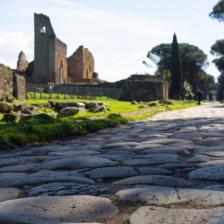
The 46th session of the World Heritage Committee, held in New Delhi, India, has inscribed the site ‘Via Appia. Regina viarum' on the UNESCO World Heritage List.
Indeed, with its 2300 years of history, Via Appia Antica holds a historical, archaeological and architectural heritage that is unique in the world. Walking or cycling among the extraordinary vestiges of the past that you encounter at every step is an unforgettable experience to be had at least once in your life.
It was designed in 312 BC by the censor Appius Claudius Caecus, who wanted to create a fast connection point between Rome and Capua to facilitate the movement of troops southwards. Later, the route was extended to Brindisi for direct communication with Greece, the East and Egypt, for military expeditions, travel and trade.
Thus, Via Appia Antica became the ‘regina viarum’ (the queen of roads), the most important road in Roman times. In the course of time, it was extended, which is why the World Heritage site also includes the variant to the original route, built by Trajan in 109 AD.
The Via Appia was also the first of the great roads that crossed the empire, built using innovative engineering techniques, an astonishing example of construction and architecture capable of illustrating a significant phase in human history, as established by criterion iv of the UNESCO Convention for the Protection of the World and Cultural Heritage of 1972.
The first 12 miles of the road, characterised by numerous famous monuments, constitute one of the most celebrated stretches of the route in art throughout the centuries; as it is materially associated with artistic or literary works, it has characteristics that satisfy criterion vi of the 1972 Convention.
In addition to the road layout, however, Via Appia includes several and numerous types of artefacts consistent with the historical phase to which the candidate site refers. These include: engineering works useful for its construction, various service infrastructures, settlements, funerary monuments, places of worship, ports and harbours, sculptures and epigraphs, tangible manifestations of the history and traditions that have affected this unique road, a place of memory and crossroads of cultures for millennia.
With the inscription of the Via Appia, Italy reaches the number of 60 sites inscribed on the prestigious World Heritage List, of which it continues to hold the record.
Photo: Redazione Turismo Roma
 Condividi
Condividi












































